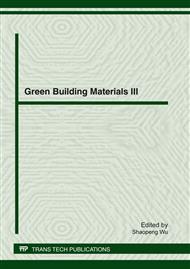p.1
p.6
p.13
p.20
p.26
p.33
p.40
p.45
Effects of Gypsum on Cementitious Systems with Different Mineral Mixtures
Abstract:
Gypsum is an indispensable component of ordinary Portland cement. The main function of gypsum is to regulate the setting time of cement. Gypsum has a great influence on water consumption of standard consistence and strength simultaneously. In this article three cementitious systems are prepared by three main mixed materials: limestone, fly ash and slag. The effect of gypsum content and the relation between gypsum quantity and the fluidity of cement with Marsh cone method are studied. Experimental results show that when the gypsum was added in the three kinds of cementitious system, water consumption of standard consistence decreased obviously, and with the quantity of gypsum increased, water demand for normal consistency reduced first, up to a certain extent tended smoothly. With the increase of gypsum quantity, initial and final setting time had different degrees of extension. While a saturation quantity is achieved, setting time will keep steady. The flexural strength and the compressive strength increased gradually and tended to be stable with the increase of gypsum quantity. When gypsum content exceeded a certain range, compressive and flexural strength decreased gradually. But gypsum content and the mobility of systems had little relativity with Marsh cone method.
Info:
Periodical:
Pages:
20-25
Citation:
Online since:
April 2012
Authors:
Price:
Сopyright:
© 2012 Trans Tech Publications Ltd. All Rights Reserved
Share:
Citation:


